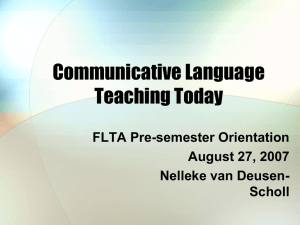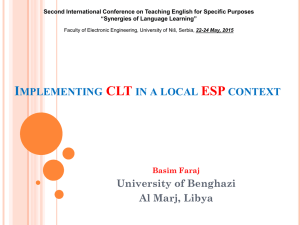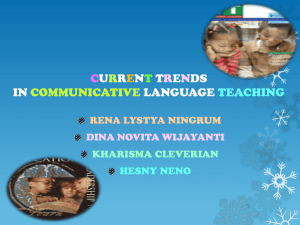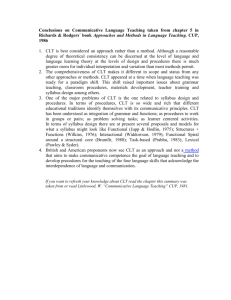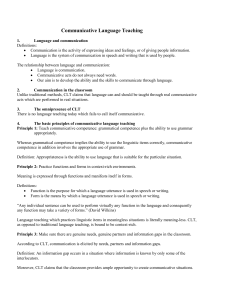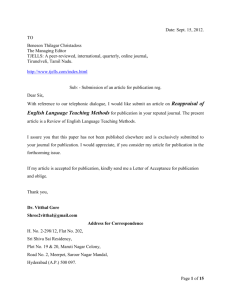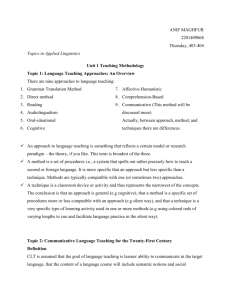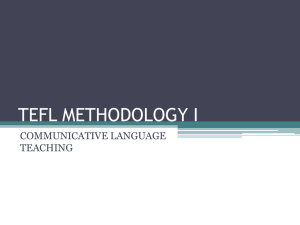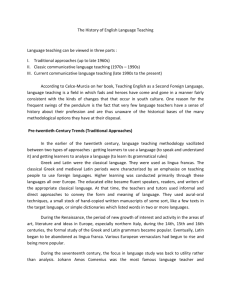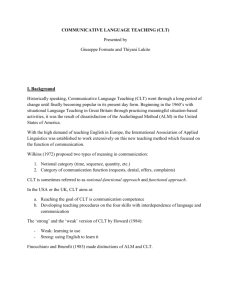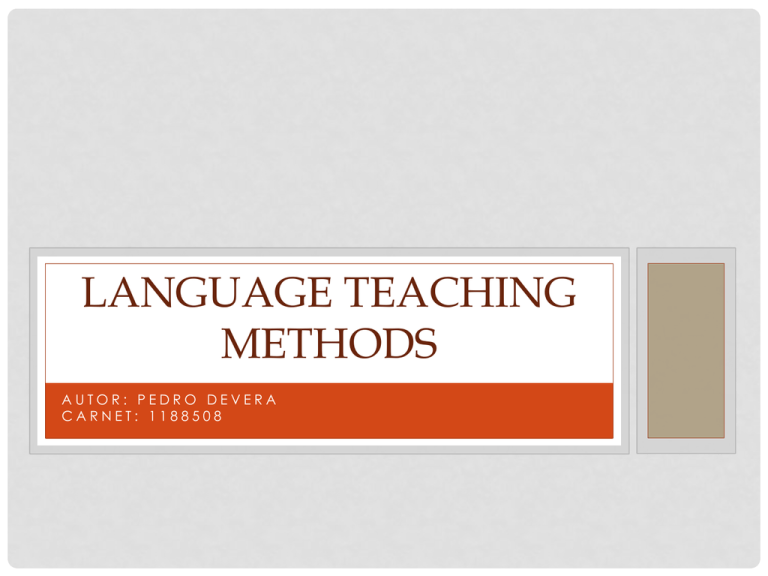
LANGUAGE TEACHING
METHODS
AUTOR: PEDRO DEVERA
CARNET: 1188508
COMMUNICATIVE LANGUAGE
TEACHING
• THEORETICAL
BACKGROUND:
_ CLT starts from a
theory of language
as communication.
The goal of language
teaching
is
to
develop what Hymes
(1972) referred to as
"communicative
competence."
• CLT is a humanistic
approach
to
teaching (Richards
& Rogers, 1986) that
aims
to
have
learners
acquire
Communicative
Competence.
COMMUNICATIVE LANGUAGE
TEACHING
• Communicative
Competence:
_
It
is
the
competence
that
enables us to convey
and
interpret
messages and to
negotiate meanings
interpersonally within
specific
contexts
(Brown, 2007).
• Theory of
Language:
_ Language is seen
as a system for the
expression of
meaning, for
interaction and
communication.
COMMUNICATIVE LANGUAGE
TEACHING
• Theory of Language
Learning:
_ Language learning
comes about through
using language
communicatively.
• Practical Applications:
_ Improve students’
abilities to use the target
language in real
contexts.
_ Prepare learners to use
the target language for
communication
purposes.
_ LSP (Language for
Specific Purposes).
COMMUNICATIVE LANGUAGE
TEACHING
• CLT PROS:
_ Focus on learners’ needs.
_ It promotes
communicative
competence acquisition.
_ It prepares students to
interact in the target
language situation.
• CLT CONS:
_ It requires teachers to
have a native like
command of the target
language.
_ It requires knowledge of
the target culture and
discourse.
_ The main hindrances to
the use of CLT in
venezuelan highschools
appear to be the
grammar-based
examination
system and the curriculum.
COMMUNICATIVE LANGUAGE
TEACHING
• Personal Opinion
CLT is a complex approach
that demands resources
such as well-trained
teachers, diverse materials
and even a compatible
curriculum; all these make
its implementation in
venezuelan highschool
education an uphill task.
• References
• Richards, J., & Rodgers, T.
(1986). Approaches and
Methods in Language
Teaching. United
Kingdom, UK. Cambridge
University Press.
• Brown, H. (2007).
Principles of Language
Learning and Teaching,
fifth edition. United States
of America. Pearson –
Longman.
SUGGESTOPEDIA
• THEORETICAL BACKGROUND:
• Theory of Language:
_ Suggestopedia is a specific set
of learning recommendations
derived
from
Suggestology,
which Lozanov describes as a
"science ... concerned with the
systematic
study
of
the
nonrational and/or nonconscious
influences" that human beings
are constantly responding to
(Stevick 1976: 42). Suggestopedia
tries to harness these influences
and redirect them so as to
optimize learning (Richards &
Rogers, 1986).
_ A view of language in which
lexis is central and in which
lexical translation rather than
contextualization is stressed.
• Theory of Language Learning:
_ Language learning involves
loading the memory banks with
desired and facilitating
memories.
SUGGESTOPEDIA
• Practical
Applications:
_ Language
teaching.
_ Potential use in
verbal knowledge
learning.
• PROS:
_ It seems to relax
students while
learning.
_ It seems to promote
fast learning.
SUGGESTOPEDIA
• CONS
_ It is a pseudo-science.
_ Its methodology needs
further scientific validation to
discriminate what works and
what does not work.
_ Many resources are needed
for the method to be used.
_ Special training which may
be difficult to get from an
official and authorized source.
_ Expensive, case Alpha
Learning.
_ Not suitable to venezuelan
highschool education.
• Personal Opinion
_ This is a method based on
suggesting learners beliefs so
they can trust the
effectiveness of a method
scientifically not validated.
_ All its results appear to be
the product of a placebo
effect.
_ Personally, I find it no use for
highschool education.
SUGGESTOPEDIA
REFERENCE
Richards, J., & Rodgers, T. (1986). Approaches and
Methods in Language Teaching. United
Kingdom, UK. Cambridge University Press.

